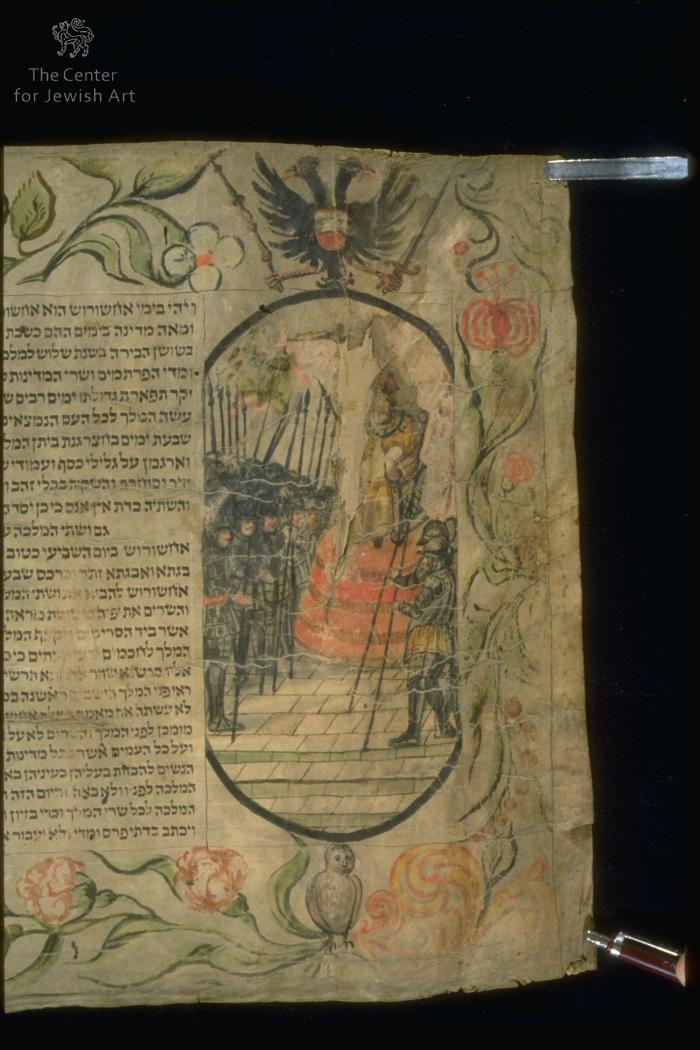Img. ID: 2599

The bearded king wearing a red pointed cap or turban (?) is seated on a throne placed on a pedestal with four steps. The figure of Ahasuerus is incomplete due to a large defect in the membrane; it was supplemented with a piece of paper, however, no attempt was made to re-create the decoration on it. A troop of soldiers carrying spears or halberds and dressed in full armor stands on the right of the king and two other soldiers stand on his left. The panel is surmounted by an armorial device of a black double-headed eagle holding a scepter in its right leg and a sword in the left one. On the eagle's chest, there is a shield with three bands, alternately in red and white that suggests that the coat of arms of Austria is depicted here.
The length of the sheets in the scroll: 1) ca. 600 mm, 2) ca. 710 mm, 3) ca. 700 mm, 4) ca. 615 mm, 5) at least 70 mm, but it is very difficult to unroll this part of the scroll.
Dimensions of the selected details in the scroll:
- decoration on the right edge of the first sheet: ca. 37 mm (width);
- opening illustration: 220x100 mm;
- an average illustration: 202x72 mm;
- illustration no. 6: 53x165 mm;
- illustration no. 13: 202x51 mm;
- illustration no. 14: 202x87 mm;
- upper margin: 55 mm;
- lower margin: 60 mm;
- text columns: 209-222x107-185 mm;
- col. 9: 221 x 121 mm;
- an average letter: 4 mm (height);
- letters in col. 9: 6 mm (height);
- letters ח in Es. 1:6 and ת in Es. 9:29: 8 mm (height).
In general, the scroll is crumpled and dirty, but especially its opening section is very damaged, dark, and dirty.
A piece of paper is glued underneath the membrane but the decoration is not reconstructed on it. Also, the final part of the scroll is seriously damaged.
In numerous places, the paints are flaked off and the green color is faded.
The ink of the text has partly flaked off in some columns, but in general, the text is preserved in good condition.
The edges of the membranes are straight but rather dirty.
The Book of Esther in Hebrew
The scroll is formed of 5 membranes containing a total of 11 columns with 26-27 lines per each, except for the col. 9 with 11 lines divided into two half-columns.
The first membrane contains 2 columns, each of the 3 other membranes contains 3 columns of the text, and on the fifth sheet, only illustration is painted.
The text is inscribed in Hebrew square Ashkenazi stam script with tagin, in brown and brown-black ink on the flesh side of parchment membranes that are rather dark and suede, thick but not stiff. Both sides of parchments are very similar.
The letters ח (Es. 1:6) and ת (Es. 9:29) are enlarged and bolded. The letter ח is additionally decorated with scrolled feet. Other enlarged and diminished letters are included in col. 9.
The letters of the Tetragrammaton and the name Ehyeh are enlarged.
In the word נדחף (col. 6), the letter פ is written with a tendril inside. Other decorated letters are in words ויזתא (col. 9) and זרעו (col. 11).
Col. 8 contains numerous elongated letters.
The ruling - horizontal and vertical lines - is made with a hardpoint. The horizontal lines are ruled across the width of the membranes.
The pricking is visible on the opening edge of the scroll.
The membranes in the scroll are glued together and reinforced with leather patches on the glued edges.
A short piece of parchment was sewn to the fourth sheet (that is the last sheet in the scroll) to complete the illustration.
The edges on both ends of the scroll are cut straight.
The text is written with the ink of different shades.
In the place where the first and the second sheet are glued, on their blank side, a small piece of a German (?) newspaper is glued.
It seems that until ca. 1932, the scroll belonged to the collection of Sally Kirschstein in Berlin.
According to the Jewish Historical Institute Museum card from November 24th, 1988, the scroll was transferred to the Jewish Historical Institute Museum in 1948 from the Central Storage of the MKiS (Ministry of Culture and Art), in Narożyn, in the Kłodzko region in the county of Wroclaw.
The former shelfmarks of the manuscript - 192, L81-5 (on a sticker), 6714, and B-409 - are written on the backside of the opening edge of the scroll, at the bottom.
Formerly manuscript no. C-254/2.
Online collection of the ritual objects from the E. Ringelblum Jewish Historical Institute is available on https://cbj.jhi.pl/documents/589836/0/ (accessed on 02.07.2021).
Marian Fuks, Zygmunt Hoffman, Maurycy Horn, Żydzi polscy. Dzieje i kultura, Warsaw 1982, 102 (a fragment of the scroll is reproduced).
Iwona Brzewska, Magdalena Sieramska, Katalog, rzemiosło artystyczne, [in:] Muzeum Żydowskiego Instytutu Historycznego. Zbiory artystyczne, Warsaw 1995, 34, figs. 58, 59.
Die Judaica-Sammlung S. Kirschstein Berlin. Kultgeräte für Haus und Synagoge, Manuskripte, Gemälde, Miniaturen, Graphik, Urkunden, Bücher. Versteigerung in der Galerie Hugo Helbing München (...) [12–14 Juli 1932]. Ausstellung in der Galerie Hugo Helbing München (...) [8–11 Juli 1932], München 1932, p. 11, object no. 188.
Mendel Metzger, Die Illustration einiger Midraschim zum Buche Esther in der Jüdischen Kunst, „Das neue Israel”, 566–567.
Juedisches Lexikon, Berlin 1980, B. IV/I, color plate by the title page.
The Decorated Esther Scrolls from the Museum of the Jewish Historical Institute in Warsaw and the Tradition of Megillot Esther Decoration in the Seventeenth and Eighteenth Centuries – An Outline [Polish: Dekorowane zwoje Estery z Żydowskiego Instytutu Historycznego w Warszawie na tle tradycji dekorowania megilot Ester w XVII i XVIII wieku. Zarys problematyki], Warsaw 2019, 1:248-272, 2:17-26.
Jewish Historical Institute Museum card no. C-254/2.



